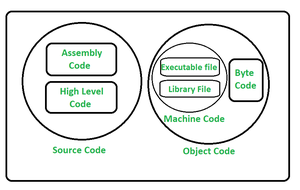源代码是指由人类/程序员生成的高级代码或汇编代码。源代码易于阅读和修改。它由程序员使用任何人类可读的高级语言或中级语言编写。源代码包含程序员为了更好地理解而添加的注释。
源代码提供给语言翻译器,翻译器将其转换为机器可理解的代码,称为机器代码或目标代码。计算机无法理解直接的源代码,计算机理解机器代码并执行它。它被认为是计算机的基本组成部分。简单地说,我们可以说源代码是由程序员使用 C、C++、 Java、 Python、汇编语言等计算机编程语言编写的一组指令/命令和语句。因此,在任何编程中编写的语句语言被称为源代码。

字节码是源代码和机器码之间的中间代码。它是一种低级代码,是用高级语言编写的源代码编译的结果。它由像Java虚拟机 (JVM) 这样的虚拟机处理。
字节码在被解释器翻译成机器码之后是不可运行的代码,然后它才能被机器理解。它被编译为在 JVM 上运行,任何包含 JVM 的系统都可以运行它,而不管它们的操作系统如何。这就是Java独立于平台的原因。字节码被称为可移植码。
下图说明了源代码和字节码的排列——

源代码和字节码的区别:
|
S.NO. |
Source Code |
Byte Code |
|---|---|---|
| 01. | Source code is written by a human or programmer. | Byte code is not written by humans or programmers. |
| 02. | It is written by using some high-level programming language. | Byte code is an intermediate code between the source code and machine code. |
| 03. | It is the input to the compiler and it is translated by the compiler or other language translator. | It is the input to the interpreter |
| 04. | The source code is not directly understandable by the system/machine. | Byte code is executable by a virtual machine. |
| 05. | The source code may contain comments. | Byte code does not contain comments. |
| 06. | Source code is in the form of plain text similar to the English language. | Byte code is in the form of numeric codes and constants. |
| 07. | Source code is more understandable by humans. | Byte code is less understandable by humans. |
| 08. | Its speed is minimum than the byte code. | Its speed is maximum than the source code. |
| 09. | The performance of source code is less than byte code. | The performance of the byte code is more than the source code. |
| 10. | It is a high-level code. | It is an intermediate-level code. |